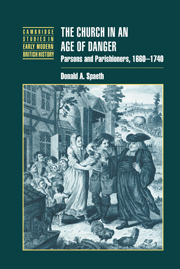Book contents
- Frontmatter
- Contents
- List of tables
- Acknowledgements
- List of abbreviations
- 1 Introduction
- 2 Clerical profiles
- 3 Arenas for conflict
- 4 The management of disputes
- 5 Pastoral care
- 6 Tithes and religious conflict
- 7 The nonconformist threat
- 8 Popular observance
- 9 Matters of life and death
- 10 Singing and religious revival
- 11 Conclusion
- Selected bibliography
- Index
- Cambridge Studies in Early Modern British History
4 - The management of disputes
Published online by Cambridge University Press: 28 July 2009
- Frontmatter
- Contents
- List of tables
- Acknowledgements
- List of abbreviations
- 1 Introduction
- 2 Clerical profiles
- 3 Arenas for conflict
- 4 The management of disputes
- 5 Pastoral care
- 6 Tithes and religious conflict
- 7 The nonconformist threat
- 8 Popular observance
- 9 Matters of life and death
- 10 Singing and religious revival
- 11 Conclusion
- Selected bibliography
- Index
- Cambridge Studies in Early Modern British History
Summary
Religion is one sphere of activity often thought to be inevitably under the control of the squire. The country gentry had an interest in defending the Established Church, just as the Church supported the social and political hierarchy, a marriage of church and state that J. C. D. Clark has termed the ‘confessional state’. Sir Roger de Coverley provides the archetypal example of the relationship between the gentry, the clergy and the people. The church that Sir Roger ornamented provided an arena for the confirmation of his authority. At the end of services, the congregation showed their respect for the squire by forming a double row through which he processed and bowing to him as he passed. The squire and parson co-operated in governing the parish. The latter mediated local disputes on behalf of Sir Roger and sought favours for members of the congregation. Yet, as Addison observed, the social relations in many parishes were not as amicable as they were in Coverley.
Disputes between the clergy and the laity had serious implications for eighteenth-century society. Their occurrence may appear to cast into doubt the robustness of the ‘confessional state’. John Phillips has argued that the clergy were faced with an individualistic population who required very careful handling and whose deference was illusory. We should not assume that a rigid alliance between the gentry and the clergy prevailed.
- Type
- Chapter
- Information
- The Church in an Age of DangerParsons and Parishioners, 1660–1740, pp. 83 - 107Publisher: Cambridge University PressPrint publication year: 2000

